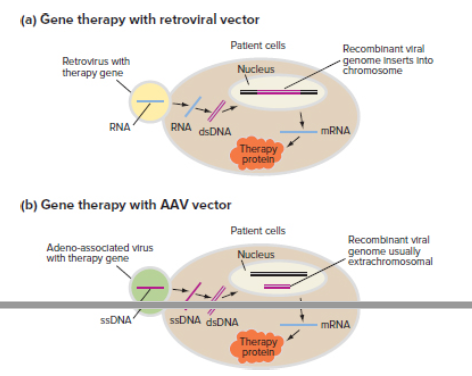
Concept explainers
The first page of this chapter (p. 575) shows a picture of Glofish ®, transgenic zebrafish (Danio rerio) that express GFP. Glofish were the first GM pets. Genes can be transferred into the zebrafish genome using a transposable element called Tol2 from medaka fish (Oryzias latipes). The Tol2 transposon serves as a vector for gene transfer in a manner similar to Drosophila P elements as shown in Fig. 17.4 on p. 578.Here, researchers inject two-cell stage zebrafish embryos with two DNAs: One DNA expresses the Tol2 transposase gene, while the other recombinant transposon contains the transgene. If the transposon hops into a chromosome of a germ-line cell, a stable line of transgenic fish can be established.
Scientists have synthesized several different genes encoding derivatives of GFP (and also RFP, a fluorescent red protein from coral). The derivatives have amino acid changes that alter their color, so that fish glowing green, red, orange, blue, or purple are available in many pet stores.
| a. | Diagram the two recombinant DNA constructs needed to generate the fluorescent fish. |
| b | Why is a transposon from medaka fish used rather than a zebrafish transposon? |

Want to see the full answer?
Check out a sample textbook solution
Chapter 17 Solutions
Genetics: From Genes to Genomes, 5th edition
- when we collect fish or mussels we record a variety of biological information, including but not limited their sex, length, weight or a scale or finray or other tissue sample. Why do we do this, and what information are we hoping to obtain from these measurements and taking these samples?arrow_forwardDraw a rough sketch of the control and experimental data using a normal dose/response curve plot: i.e. % of total bound ligand vs. concentration. Indicate Kd and Bmax on this sketch. You don’t need to use exact numbers, but the relative proportions should be closearrow_forwardName something that could be happening to glutamate transporters that could have this effect on glutamate transport (i.e. the difference in glutamate transporters between control and experimental conditions). (Bonus: if you can also guess what the experimental condition is).arrow_forward
- a. For the control condition, calculate Kd. Include units and show your work. b. For the control condition, calculate Bmax. Include units and show your work. c. For the experimental condition, calculate Kd. Include units and show your work. For the experimental condition, calculate Bmax. Include units and show your work.arrow_forwardNow draw a rough sketch of what the control data might look like if in addition to the specific binding, there was also a considerable amount of nonspecific binding (again using a normal dose/response curve)arrow_forwarda. Which drug is the most potent? a,b,c,d,e b. Which drug has the highest efficacy?arrow_forward
- The shape of radishes may be long (SL/SL), oval (SL/SS), or round (SS/SS), and the color of radishes may be red (CR/CR), purple (CR/CW) or white (CW/CW). If a long, red radish plant is crossed with a round, white plant, what will be the appearance of the F1 and F2 generations?arrow_forwardNonearrow_forwardQuestion #3: In the KeyGene paper, the authors state that it would be useful if pollen from an apomict would transmit apomixis-inducing genes to the female in the cross (assuming the pollen is viable). Assuming there was just one gene conferring gametophytic obligate apomixis, and that the two parents are inbreds, what would be the consequences of such a cross if: a) The apomixis was a dominant trait? Indicate the genotypes and phenotypes (apomict or non- apomict) of the parents, F1 and F2 generations. Remember to include the expected genotypic and phenotypic ratios (or percentages) in the F1 and F2 generations, and to position the female first (left side) in the parental cross. b) The apomixis was a recessive trait? Indicate the genotypes and phenotypes (apomict or non- apomict) of the parents, F1 and F2 generations. Remember to include the expected genotypic and phenotypic ratios (or percentages) in the F1 and F2 generations, and to position the female first (left side) in the…arrow_forward
 Biology Today and Tomorrow without Physiology (Mi...BiologyISBN:9781305117396Author:Cecie Starr, Christine Evers, Lisa StarrPublisher:Cengage Learning
Biology Today and Tomorrow without Physiology (Mi...BiologyISBN:9781305117396Author:Cecie Starr, Christine Evers, Lisa StarrPublisher:Cengage Learning Biology (MindTap Course List)BiologyISBN:9781337392938Author:Eldra Solomon, Charles Martin, Diana W. Martin, Linda R. BergPublisher:Cengage Learning
Biology (MindTap Course List)BiologyISBN:9781337392938Author:Eldra Solomon, Charles Martin, Diana W. Martin, Linda R. BergPublisher:Cengage Learning Human Heredity: Principles and Issues (MindTap Co...BiologyISBN:9781305251052Author:Michael CummingsPublisher:Cengage Learning
Human Heredity: Principles and Issues (MindTap Co...BiologyISBN:9781305251052Author:Michael CummingsPublisher:Cengage Learning Biology 2eBiologyISBN:9781947172517Author:Matthew Douglas, Jung Choi, Mary Ann ClarkPublisher:OpenStax
Biology 2eBiologyISBN:9781947172517Author:Matthew Douglas, Jung Choi, Mary Ann ClarkPublisher:OpenStax Biology: The Dynamic Science (MindTap Course List)BiologyISBN:9781305389892Author:Peter J. Russell, Paul E. Hertz, Beverly McMillanPublisher:Cengage LearningCase Studies In Health Information ManagementBiologyISBN:9781337676908Author:SCHNERINGPublisher:Cengage
Biology: The Dynamic Science (MindTap Course List)BiologyISBN:9781305389892Author:Peter J. Russell, Paul E. Hertz, Beverly McMillanPublisher:Cengage LearningCase Studies In Health Information ManagementBiologyISBN:9781337676908Author:SCHNERINGPublisher:Cengage





